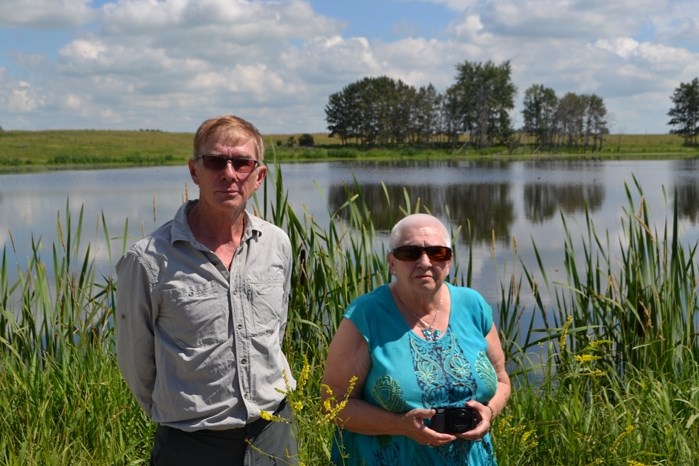For the past 13 years Innisfail senior Bernice Stewart has been a regular visitor to Cook Lake, a small spring-fed body of water that is the migratory home for countless birds.
Cook Lake, a kilometre east of the town's northeast boundary, is a place of serenity for Stewart, and many other passionate wildlife lovers who spend many hours each week in commune with nature's glory. It's a peaceful natural sanctuary for photographers, like Stewart, who capture intimate natural moments of a lesser scaup, American coots, blue winged teals, redheads, canvasbacks, northern shovelers, ruddy ducks, Canada geese, red winged blackbirds, cedar waxwings, bald eagles and swans.
“I have seen flock after flock of mallards fly in in the fall, until the water is just teeming with them,” said Stewart, who has snapped thousands of pictures of Cook Lake's seasonal wildlife inhabitants. “I have seen a pied billed grebe removing the membrane from the nest after her chick hatched, then swim off with the egg shell. Then the babies struggle onto the mother's back and get under her soft feathers to stay warm. I cannot describe the feeling I get when I see these things.”
However, this feeling of wonder is now threatened.
Preliminary work has begun around the 700-metre-long lake for a future AltaLink transmission line that will cross it from west to east. The line, which was the company's alternate route for its $51-million substation project, was approved in 2014 by the Alberta Utilities Commission (AUC) following extensive public consultation and hearings.
The lake is on land owned by Jack and Audrey Daines, the patriarch and matriarch of the region's famed rodeo family. For Audrey, it has been a personal mission to fight any disruption to wildlife at Cook Lake for more than five years. She wanted AUC to choose the preferred 14-kilometre AltaLink route in 2014 that would have run from the southern edge of Innisfail and east to the substation far south of Cook Lake.
“The preferred route was fine,” said Audrey.
However, the preferred route faced determined citizen and political opposition from the Wachter Group and the Town of Innisfail.
The Daineses hired a lawyer and filed an appeal to AUC to have the 2014 decision reviewed, largely on grounds the agency erred by “implicitly” finding the alternate route for the transmission line will cross a semi-permanent wetland “when in fact”, they maintained, it will go through a permanent water body – Cook Lake. The couple's appeal included its own environmental assessment to support their argument the alternative route would adversely impact Cook Lake.
However, the AUC dismissed the Daineses' appeal for a review of the 2014 decision. In its written ruling on Feb. 18, 2015, the AUC panel concluded
environmental impacts from both routes could be mitigated.
“AUC has gone to great lengths to have a full assessment and consideration of varying viewpoints and evidence. Certainly environmental considerations, including wildlife, were very much part of the decision making that is reflected in the initial decision,” said Geoff Scotton, senior communications advisor for AUC. “An overarching consideration of the Alberta Utilities Commission is the consideration of the public interest. It is in the public interest for Alberta to have a functioning efficient electrical system.
“In order to achieve that goal there are going to be people that are affected negatively from time to time, and that too has to be balanced,” added Scotton.
The Daineses concede the time is over for legal remedies to block the construction of the alternate route. Audrey and other nearby residents now want to put the issue in the public eye, hoping enough pressure will be made by nature lovers and anyone who feels it's simply wrong to block the migratory path on Cook Lake with a power line.
“I don't believe the line should go across. I have talked to various people in the government about this issue but I have not gotten anywhere,” said Richard Wagers, a long-time area landowner who lives a kilometre west of the Daines property on the west side of the QEII. “Perhaps with public support we might be able to do something.”
And then there is Stewart, who after years of visiting the birds at Cook Lake, has become friends with Audrey Daines. The Innisfailian supports any community effort that could lead to a better resolution for the long-term health of Cook Lake and its feathery visitors.
“I had the privilege of watching the mating ritual of the red-tailed hawks that have a nest on the east side of the lake. Those trees will disappear, to be replaced by power lines,” said Stewart sadly. “This is home to so many birds. I believe it is irresponsible to disrupt the lives of these birds.”
Bernice Stewart
"I have seen a pied billed grebe removing the membrane from the nest after her chick hatched, then swim off with the eggshell. Then the babies struggle onto the mother's back and get under her soft feathers to stay warm. I cannot describe the feeling I get to see these things."



